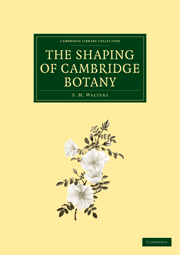 The Shaping of Cambridge Botany
The Shaping of Cambridge Botany Book contents
- Frontmatter
- Contents
- Dedication
- List of illustrations
- To Lorna
- Preface and acknowledgements
- 1 Introduction: botany, medicine and horticulture
- 2 Ray and the herborising tradition
- 3 Bradley and the horticultural tradition
- 4 The Martyns and the Linnaean tradition
- 5 Henslow and the rise of natural science
- 6 Babington, Vines and Lynch: the fragmentation of botany
- 7 The New Botany School: Marshall Ward and his successors
- 8 Whole-plant botany and the modern Botanic Garden
- Bibliography
- Index
1 - Introduction: botany, medicine and horticulture
Published online by Cambridge University Press: 05 July 2011
- Frontmatter
- Contents
- Dedication
- List of illustrations
- To Lorna
- Preface and acknowledgements
- 1 Introduction: botany, medicine and horticulture
- 2 Ray and the herborising tradition
- 3 Bradley and the horticultural tradition
- 4 The Martyns and the Linnaean tradition
- 5 Henslow and the rise of natural science
- 6 Babington, Vines and Lynch: the fragmentation of botany
- 7 The New Botany School: Marshall Ward and his successors
- 8 Whole-plant botany and the modern Botanic Garden
- Bibliography
- Index
Summary
There are many books on the history of biology, or of botany as a separate science, but it is not easy to distil from them certain relevant ideas which I believe to be important in understanding the shape of modern botanical science. Indeed, I have been forced to the conclusion that much of the written account of the history of biology is liable to be misinterpreted by many readers. Since I was myself until recently guilty of such misinterpretation, I feel that it would be useful to clarify the matter here, before we start on the particular history of the Cambridge School of Botany and the Cambridge Botanic Garden.
It is common knowledge that the science of botany developed from a study of plants as useful to cure diseases, and that the oldest surviving Botanic Gardens, at Padua and Pisa in Italy, were founded in the middle of the sixteenth century as ‘herb gardens’ whose primary purpose was to grow the medicinal plants important to the medical science of the time. The foundation of such gardens in connection with universities and centres where there were flourishing medical schools proceeded quite rapidly in the late sixteenth and early seventeenth centuries, and the first British Botanic Garden was founded in 1621 in the University of Oxford.
- Type
- Chapter
- Information
- The Shaping of Cambridge BotanyA Short History of Whole-Plant Botany in Cambridge from the Time of Ray into the Present Century, pp. 1 - 5Publisher: Cambridge University PressPrint publication year: 1981
